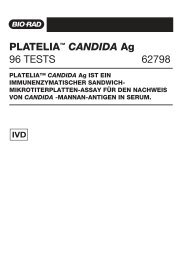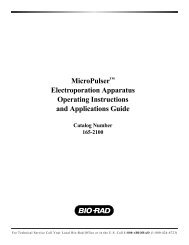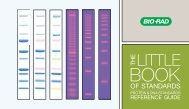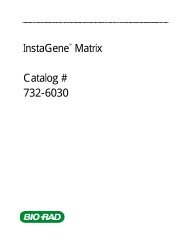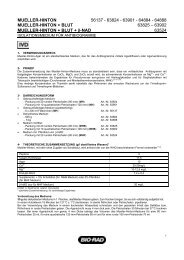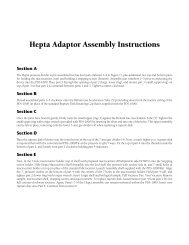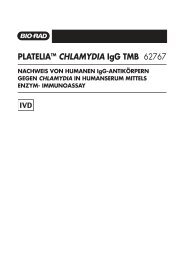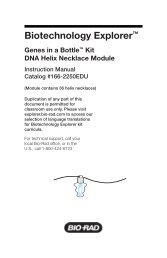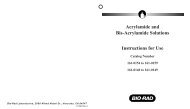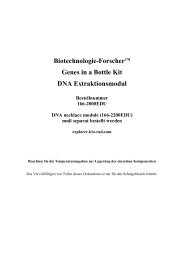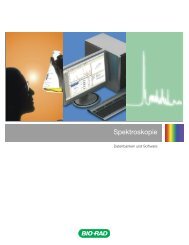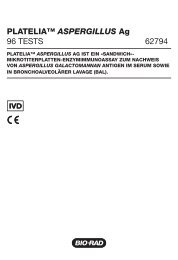Protein Expression and Purification Series - Bio-Rad
Protein Expression and Purification Series - Bio-Rad
Protein Expression and Purification Series - Bio-Rad
Create successful ePaper yourself
Turn your PDF publications into a flip-book with our unique Google optimized e-Paper software.
CHAPTER 1<br />
BACKGROUND<br />
<strong>Protein</strong> <strong>Expression</strong> <strong>and</strong> <strong>Purification</strong> <strong>Series</strong><br />
Desalting the sample is performed using a size exclusion gel prepacked in a spin column. The gel, <strong>Bio</strong>-Gel<br />
P-6, has a fractionation range of 1,000 to 6,000 Da. This means that the pores of the gel are large enough<br />
to allow molecules in the 1 to 6 kD range, like salts <strong>and</strong> small proteins, to enter, but larger molecules, such<br />
as GST-DHFR-His, with a molecular weight of 52 kD, will be excluded <strong>and</strong> flow through the column. In<br />
essence, the salts (imidazole, NaCl <strong>and</strong> phosphate buffer) are trapped in the gel while the protein of interest<br />
comes out “clean” in a Tris buffer.<br />
Methods To Quantify <strong>Protein</strong> Concentration <strong>and</strong> Check <strong>Protein</strong> Purity<br />
Once the protein of interest (GST-DHFR-His) is purified it is necessary to check its purity <strong>and</strong> determine the<br />
quantity of protein purified. There are multiple ways to perform these tasks.<br />
Absorbance at 280 nm<br />
The aromatic amino acids (tryptophan, <strong>and</strong> to a lesser degree tyrosine <strong>and</strong> phenylalanine) in proteins<br />
absorb at 280 nm. If the extinction coefficient (a parameter that helps define how well a substance absorbs<br />
light at a specific wavelength at a particular concentration) is known, the amount of protein present can be<br />
calculated using Beer’s Law (absorbance = εcL) where ε is the extinction coefficient, c is concentration <strong>and</strong><br />
L is the pathlength of light. If the extinction coefficient is not known, there are computer programs, such as<br />
that from Expasy (see Appendix J), that can calculate an approximate extinction coefficient from empirical<br />
relationships.<br />
It should be noted that other molecules such as imidazole absorb at 280 nm <strong>and</strong> can interfere with<br />
calculations. The buffer in which the sample is measured is critical for A280 measurements. This is one of<br />
the reasons why the second purification step in this series is performed. It is a desalting step to remove the<br />
imidazole from the GST-DHFR-His so that the A280 measurement can be taken.<br />
Colorimetric <strong>Protein</strong> Assays<br />
There are multiple colorimetric protein assays that have been developed to determine protein<br />
concentrations. The first—the Bradford protein assay—is based on a shift in the maximum absorbance<br />
of a colored dye, Coomassie Brilliant Blue G-250. The dye interacts mainly with basic amino acid groups<br />
(arginine <strong>and</strong> lysine) as well as aromatic amino acids (phenylalanine, tyrosine <strong>and</strong> tryptophan). A second<br />
method—the Lowry method—is based on reaction of the protein with an alkaline copper tartrate solution<br />
<strong>and</strong> Folin reagent. In the case of the Lowry method, color is mainly due to the presence of tyrosine <strong>and</strong><br />
tryptophan as well as cysteine <strong>and</strong> histidine. Each of these assays has its advantages <strong>and</strong> disadvantages,<br />
namely the compatibility of the assay with reagents in the buffer as well as sensitivity.<br />
SDS-PAGE Analysis<br />
Another method of determining which fractions contain the purified protein as well as the progress of<br />
the protein purification procedure, is to analyze samples by sodium dodecyl sulfate-polyacrylamide<br />
gel electrophoresis (SDS-PAGE). This method is not quantitative unless a protein st<strong>and</strong>ard of known<br />
concentration is run in one of the lanes <strong>and</strong> quantitative software is used to examine the gel image. It will,<br />
however, allow the determination of which fractions contain the protein of interest if the molecular mass<br />
is known <strong>and</strong> at what relative concentration. It will also allow the assessment of the purity of the protein<br />
fraction. If the protein is pure, a single b<strong>and</strong> should be visible on the gel, even when large quantities of the<br />
samples are loaded.<br />
<strong>Protein</strong> Structures <strong>and</strong> Basic Properties<br />
In contrast to DNA, which is quantified in terms of its length (i.e., the number of base pairs), proteins are<br />
quantified in terms of their molecular weights relative to a hydrogen atom, in Daltons. This is because DNA<br />
is composed of only 4 nucleotides, which are in roughly equal proportions <strong>and</strong> about the same molecular<br />
46 Chapter 1: Recombinant <strong>Protein</strong> <strong>Expression</strong> & <strong>Purification</strong>




